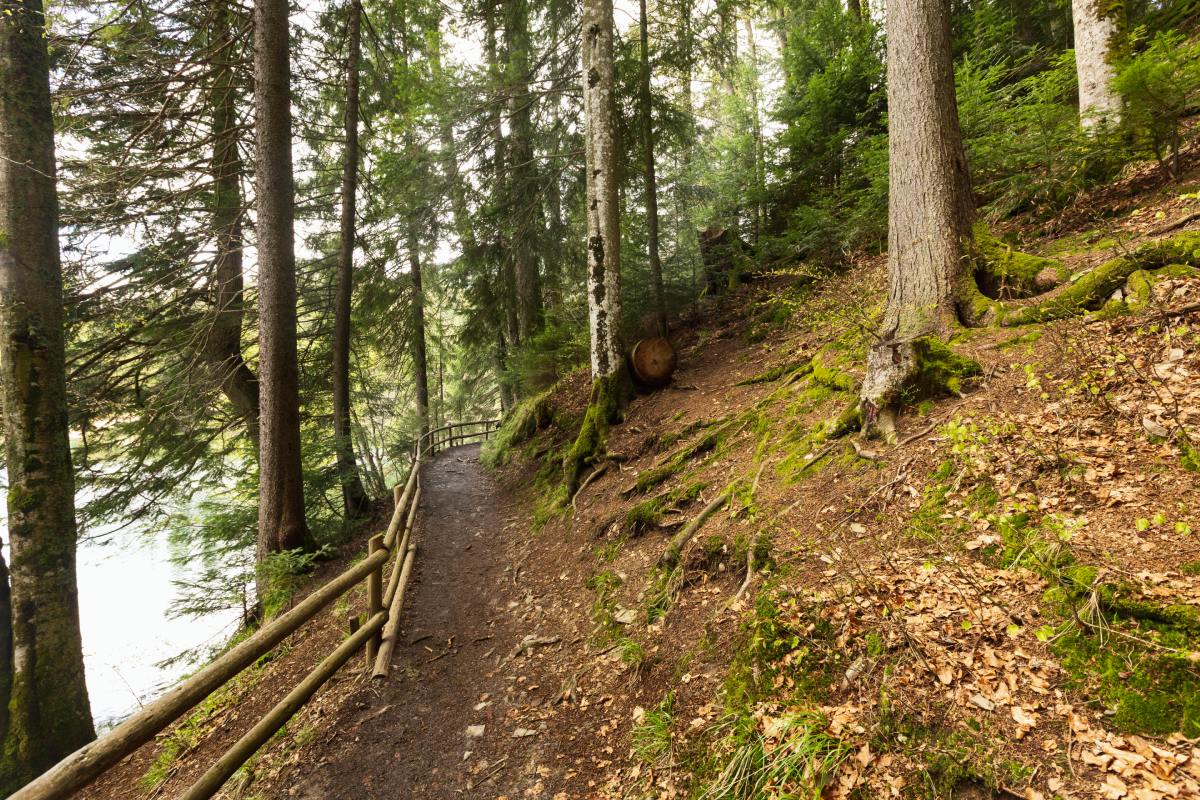A picturesque corner of the countryside located only a few kilometres from busy Prague. In this article we will explore the oldest hiking trail in our country – the Posázaví Trail. It is part of the red marked hiking route No. 001 and leads from Pikovice to Kamenný Přívoz.
History of the trail
The trail was built by the Czech Tourist Club between 1914 and 1924. It was designed by the Prague teacher Josef Kliment, after whom one of the viewpoints on the trail is named. The whole trail was supposed to be opened in 1914, but due to World War I its completion was postponed by ten years. The section between Pikovická jehla and Žampach in the place called ‘Na Babách’ was the first to be inaugurated in 1920. Due to the difficult terrain, the route had to be carved into the rock or built of stone masonry in several places, and the funds for this difficult work were raised by the Czech Tourist Club from local associations and municipalities. In return, they were promised an influx of tourists, which would ensure future profits for local businesses. The total cost of the construction amounted to CZK 230,000.
The Posázaví Trail became a favourite place for many excursionists who used the Posázavský Pacific railway line for transport to the site. The train started to run to Posázaví as early as 1900 and during the First Republic it became a popular means of transport not only for hikers but also for the first Czech tramps, who established tramp settlements along the trail. With the development of tourism, recreational facilities also began to be built on both banks of the Sázava. However, the big problem was how best to ensure the connection between the railway station in Pikovice (today’s Petrov u Prahy) and the start of the trail itself in Pikovice on the other side of the river. The Czech Tourist Club operated a ferry here, and the idea of building a footbridge was rejected in 1922 because of its difficulty. The municipality of Pikovice itself came up with the proposal again in 1932, but the Czech Tourist Club boycotted it for several years because of the profitability of its ferries. The construction and ceremonial opening of the footbridge took place in 1936. A toll was collected for its crossing until the German Nazis occupied the region.
Points of interest on the route
The entire Posázaví Trail is 10 km long and during the journey you can not only enjoy the beautiful nature, but also learn a little bit about the local surroundings. From the Petrov railway station to the slopes of the Medník hill, the Medník nature trail copies it. It was built in 1965 and at the stops along the Sázava you can learn about the history of boating, the construction of the Posázavský Pacific, invasive species and the Sázava River itself. The nature trail then ascends to Medník, where there is an information board dedicated to tramping and especially to the plant that made Medník famous – the dog’s tooth candytuft. This critically endangered plant can be recognised by its pinkish-purple flowers and dark green marbled leaves. It gets its name from its elongated bulb. You can see it growing especially if you hike in the spring. In the Czech Republic, it can only be found in this area, which is why Medník was declared a national natural monument in 1933. Interestingly, this plant is found mainly in southern Europe, so there has been a debate for several years about whether its occurrence in Medník is natural or whether it was planted artificially.
The area of Medník is also known for the alleged location of the so-called “Štěchovice treasure”. At the end of the Second World War, the Nazis needed to find a hiding place to hide a substantial part of their valuables from the advancing Soviet army in Bohemia. This task was entrusted to General Emil Klein, who chose the training area of the German Waffen SS units, located around Medník, Štěchovice and Pikovice. The location was also ideal because of its mining history, providing several areas for safe hiding. After the war, due to the liquidation of witnesses, the treasure could never be found, and although Klein himself became a prisoner of war, he never revealed the exact location of the hiding places. In 1946, the archive of K. H. Frank was secretly digged up by Americans in the Dušno gorge above the Štěchovická dam. It contained Nazi writings, but the American army took them to its occupation zone and concealed their contents. Attempts to find the Štěchovice treasure gained momentum in the 1980s and 1990s. The whole area of Mednik was occupied by the army, day and night the sounds of jackhammers and compressors could be heard from there. A large amount of building material was also transported to the site. To this day, it is not clear whether anything was taken from Medník or stored there. Some sources claim that the alleged treasure consisted of Nazi inventions, secret military weapons, passwords to Swiss bank accounts and valuables stolen from all over Europe. Other sources state that containers with unknown contents were placed underground during the work. What happened at the site will probably always remain a mystery, as the site was thoroughly reforested after the work was completed and locating the location of the mysterious excavation is now virtually impossible.
Views
On the Posázava Trail you will also find three viewpoints – Klimentova, offering a breathtaking view of the winding Sázava River, and Raisova, which is the only sitting area on the trail. Towards the end of the trail you will also come across the Žampach lookout point, from which you can see the Žampach viaduct, the second highest stone railway bridge in Central Europe, 42 metres high. For a nice photo we recommend waiting here for the crossing of the Posázavský Pacific.
The Tramp Footprint
Along the entire route you will certainly not miss the distinctive tramp footrpint. Tramps settled here on both banks of the river and you can see settlements such as Toronto, Dakota, Ajax and Kadjak.
How to get to the trail
The best and most authentic way to get to the trail is to take the train to the Petrov u Prahy stop. From there, just cross the river to Pikovice. If you are travelling by car, you can park in Pikovice right next to the trail at the parking lot in Pobřežní Street, parking for the whole day costs 50 CZK. You can also park for free in the village of Petrov at the Na Hřebenech parking lot, from where you can walk down to the railway station.
Due to the terrain and occasional steps in the rock, the trail is not suitable for cyclists and strollers.
Refreshments
For refreshment before the trip, you can visit the U Kelímka refreshment stand in the parking lot in Pikovice or have a sweet treat in the local pastry shop. At the Petrov u Prahy bus stop, there is Zelená rokle snack bar, stylishly decorated in a tramp atmosphere. Directly on the trail you will come across Starcova restaurace in front of Medník. This legendary establishment was a meeting place for canoeists and tramps until 1972, when it was closed for a number of years. Since 2018, however, hikers can once again stop here for a draft beer or homemade soup. Further upriver, there is also a well with clean water.
Accommodation
In the area there are several cottages and apartments for a pleasant stay in nature. However, if you want to experience the true undisturbed atmosphere of Posázaví, we recommend you to stay in our Cottage Daisy. It is located in the village of Bohuliby, adjacent to Petrov, with only a few holiday cottages in its surroundings. It is an ideal place for visiting the Posázaví Trail as well as for exploring several other sights and tourist attractions in the area.
Don’t hesitate to see for yourself why this part of the country is so popular with nature lovers. We are sure that you will enjoy the Posázaví Trail as much as we do!


